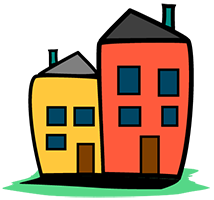Consumer-identified individuals: Perhaps the most important players in the Home Usability Network will be those individuals that the consumer identifies. The Home Usability Plan will help identify these individuals.
Example: A consumer’s brother-in-law has carpentry experience. After consulting with a trusted contractor to draft plans, he volunteers to do the work if the consumer can supply the materials. The next step would be securing funding for materials with the consumer and other HUN members
Funding : Identifying funding sources for various home usability problems may be one of your biggest challenges. Learning about the variety of funding sources available in your community is critical. Check out the funding resources page for some ideas of where to start!
Independent living (IL) skills training: Home usability is an independent living problem. Connect with an IL specialist at your center and stay informed about courses and resources offered!
Trade and labor (i.e. plumber, carpenter, electrician, architect, union representative): If the consumer’s home usability problem is going to require any type of home modification, a skilled tradesperson will need to be part of your team. These folks will have knowledge of building codes and safety issues, can help develop cost estimates, and may help brainstorm creative solutions to modification concerns.
Fair housing: It may be that some home usability problems are also fair housing concerns. In these instances, it will be helpful to have someone who understands fair housing rules and regulations. Check to see if your community has a local nonprofit fair housing organization.
Assistive technology (AT) : Home usability issues are not limited to the need for home modifications. You could save time and money by determining whether a piece of equipment can address the problem rather than an extensive home modification. Find your state AT program here.
Peers and other consumers: Having someone who can provide support to a consumer as a home usability plan is implemented may be useful. A peer is someone the consumer can identify with who has gone through similar challenges and who has received training on how to provide peer support. (see resources for ideas on peer support training programs).
Landlord/property manager: Landlords and property managers can offer a different perspective and help identify solutions that are acceptable to other landlords.
Occupational/Physical therapist: Occupational and Physical therapists (OT/PTs) spend a lot of time working with people within their homes. Their insight could be valuable for providing options for solving home usability problems.
Note on OT/PTs: Not all OTs and PTs respect consumer choice and control. If you or your center have partnered with an OT in the past, recruiting this professional as a HUN member may require less education on IL Philosophy.
Housekeeping services: Difficulty keeping your home clean and organized is a potential usability problem. If there are organizations in your community that could help provide housekeeping services it would be good to bring them on board. Does your community have senior companions? Check with your local agency on aging to find out!
Other CIL staff: Other center staff will have a diverse set of skills and a wide range of expertise. Think about the various roles different staff members at your center play. Is someone on staff an expert in Social Security or Medicaid benefits? Is someone else an excellent networker who knows everyone in the community? These are potential network members who could provide invaluable information and advice when needed.
More: The resources listed here are just the beginning, you may identify more resources that are unique to your consumers and your community!

